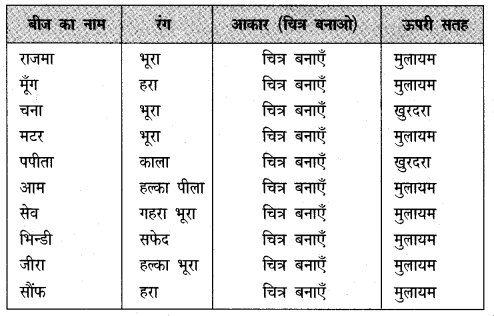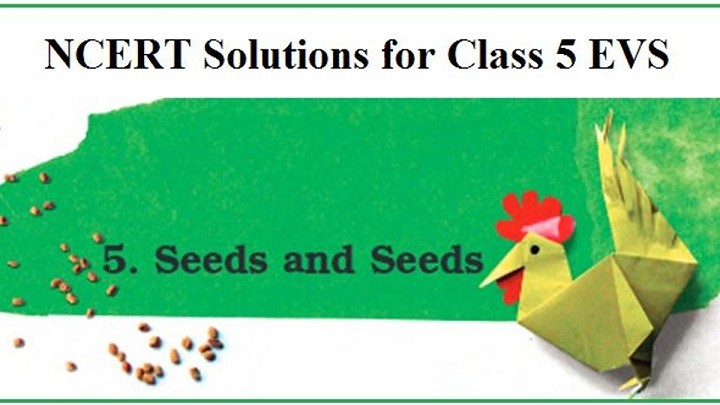NCERT Solutions for Class 5 Chapter 5 Seed, Seed, Seed
NCERT Solutions पर्यावरण अध्ययन Chapter 5 बीज ,बीज ,बीज
एन.सी.ई.आर.टी. पाठ्यपुस्तक (पृष्ठ संख्या 42)
चर्चा करो
प्रश्न 1.
तुम्हारे घर में कौन-कौन सी चीजें खाना बनाने से पहले भिगोई जाती है? और क्यों?
उत्तर:
मेरे घर में चना, मूंग, मटर, राजमा, आदि को बनाने से पहले भिगोया जाता है। इनके दाने बहुत कड़े होते हैं जिन्हें पकाने में बहुत समय लगता है। भिगोने से ये मुलायम हो जाते हैं तथा इन्हें पकाने में भी बहुत कम समय लगता है।
प्रश्न 2.
तुम्हारे घर में कौन-कौन सी चीजें अंकुरित करके खाई जाती हैं? उन्हें अंकुरित कैसे किया जाता है? कितना समय लगती है?
उत्तर:
मेरे घर में चना तथा मँग अंकुरित करके खाए जाते हैं। चने या मूंग को पानी में रात भर भिगोया जाता है। सुबह उसे पानी से निकाल कर गीले कपड़े से बाँधकर छोड़ दिया जाता है। चने को अंकुरित होने में 36 से 48 घंटे तथा मूंग को अंकुरित होने में 24 से 32 घंटे लगते हैं।
प्रश्न 3.
क्या तुम्हें या तुम्हारे आस-पास किसी को डॉक्टर ने अंकुरित खाना खाने की सलाह दी है? क्यों?
उत्तर:
हाँ, मेरी माँ को डॉक्टर ने अंकुरित खाना खाने की सलाह दी है। ये बहुत ही पौष्टिक होते हैं।
एन.सी.ई.आर.टी. पाठ्यपुस्तक (पृष्ठ संख्या 43)
करके देखो।
याद है, कक्षा चार में जड़ों का जाल पाठ में तुमने बीज के प्रयोग किए थे। आओ, एक और प्रयोग करके देखें।
1. चने के कुछ दाने और तीन कटोरियाँ लो। पहली कटोरी में चने के चार-पाँच दाने लो और कटोरी को पानी से पूरा भर दो।
2. दूसरी कटोरी में भी उतने ही चने भीगी हुई रूई या कपड़े में लपेटकर रख दो। ध्यान रहे, कपड़ा या रूई सूखने न पाये। तीसरी कटोरी में केवल चने ही रखो।
3. तीनों कटोरियों को ढंक दो।। दो दिन बाद देखो और लिखो। कटोरियों के चनों में क्या बदलाव दिखा?
| कटोरी 1 | कटोरी 2 | कटोरी 3 | |
| क्या बीजों को हवा मिल रही है? | नहीं | हाँ | हाँ |
| क्या बीजों को पानी मिल रहा है? | हाँ | हाँ | नहीं |
| बीजों में क्या बदलाव आया? | बीज काले पड़ गये | बीज फूल कर बड़े हो गये | कोई बदलाव नहीं |
| क्या बीजों में अंकुरण हुआ? | नहीं | हाँ | नहीं |
बताओ और लिखो
प्रश्न 1.
किस कटोरी के बीजों में अंकुरन हुआ? इस कटोरी और बाकी कटोरियों के बीजों में क्या अंतर है?
उत्तर:
अंकुरन केवल दूसरे कटोरे में हुई। कटोरी 2 के चने को पानी और हवा दोनों मिले। कटोरी 1 के चने को केवल पानी ही मिला। कटोरी 3 के चने को केवल हवा ही मिली। अंकुरन के लिए हवा और पानी दोनों जरूरी हैं।
प्रश्न 2.
गोपाल की माँ ने भिगोए हुए चने अंकुरित करने के लिए गीले कपड़े में क्यों बाँधे?
उत्तर:
गोपाल की माँ ने भिगोये हुए चने अंकुरित करने के लिए गीले कपड़े में इसलिए बाँधे ताकि चने को पानी तथा हवा दोनों मिलें।
प्रश्न 3.
साबुत मसूर की दाल को हम अंकुरित नहीं कर पाते। सोचो क्यों?
उत्तर:
साबूत मसूर की दाल बनने में मसूर को कई प्रक्रिया से गुजरना पड़ता है। इसके कारण उसकी अंकुरित होने की क्षमता खत्म हो जाती है।
प्रश्न 4.
अपने अंकुरित बीज को ध्यान से देखो और उसका चित्र बनाओ?
उत्तर:
एन.सी.ई.आर.टी. पाठ्यपुस्तक (पृष्ठ संख्या 44)
किसका पौधा कितना बड़ा?
एक गमला या चौड़े मुँह वाला डिब्बा लो। इसके नीचे छोटा-सा छेद करके, मिट्टी भरो। किसी एक किस्म के चार-पाँच बीज मिट्टी में दबा दो । कक्षा में सभी बच्चे अलग-अलग किस्म के बीज बोएँ। जैसे-सरसों, मेथीदाना, तिल, धनिया।
लिखो
1. बीज के नाम ………
2. किस दिन बोया (तारीख) ……..
3. अब जिस दिन से तुम्हें छोटा-सा पौधा निकलता दिखे, उस दिन से अपनी तालिका भरो।
उत्तर:
बीज का नाम सरसों
बीज बोने की तिथि पाँच नवम्बर
| तारीब | पौध की लम्बाई (से.मी.) | कितने पत्ते दिखे | कोई और बदलाव |
| 5 नवम्बर | 1/2 से.मी. | 2 | नहीं |
| 6 नवम्बर | 2 से.मी. | 3 | नहीं |
| 7 नवम्बर | 21/2 से.मी. | 4 | तना मोटा हो गया। |
| 8 नवम्बर | 4 से.मी. | 6 | तना और भी मोटा हो गया |
एन.सी.ई.आर.टी. पाठ्यपुस्तक (पृष्ठ संख्या 45)
पता करो
प्रश्न 1.
बीज बोने और छोटा पौधा दिखने में कितने दिन लगे?
उत्तर:
बीज बोने और छोटा पौधा दिखने में 6 से 7 दिन लगे।
प्रश्न 2.
पहले दिन और दूसरे दिन पौधे की लंबाई में कितना अंतर था?
उत्तर:
पहले दिन और दूसरे दिन पौधे की लंबाई में 1/2 से.मी. का अंतर था।
प्रश्न 3.
किस दिन पौधे की लंबाई सबसे ज्यादा बढ़ी?
उत्तर:
तीसरे दिन पौधे की लम्बाई सबसे ज्यादा बढ़ी।
प्रश्न 4.
क्या हर दिन पौधे में नया पत्ता या पत्ते निकले?
उत्तर:
हाँ, हर दिन पौधे में से नये पत्ते निकले।
प्रश्न 5.
क्या पौधे के तने में भी कुछ बदलाव आया?
उत्तर:
हाँ, पौधे के तने दिनों दिन मोटे तथा मजबूत हो गए।
चर्चा करो
प्रश्न 1.
किस बीज के पौधे को मिट्टी से बाहर आने में सबसे ज्यादा दिन लगे?
उत्तर:
तिल के बीज को मिट्टी से बाहर आने में सबसे ज्यादा समय लगता है।
प्रश्न 2.
किस बीज के पौधे को मिट्टी से बाहर आने में सबसे कम दिन लगे?
उत्तर:
सरसों के बीज को मिट्टी से बाहर निकलने में सबसे कम दिन लगे।
प्रश्न 3.
कौन-सा बीज उगा ही नहीं? क्यों नहीं उगा होगा?
उत्तर:
जिन बीजों को सही मात्रा में पानी और हवा मिली वे सभी अच्छे उगे। जिन्हें पानी और हवा नहीं मिली वे पौधे नहीं
उग पाये।
प्रश्न 1.
अगर तुम्हारा पौधा सूख गया या पीला हो गया तो सोचो ऐसा क्यों हुआ होगा?
उत्तर:
पौधे पानी की कमी से पीले होते और फिर सूख जाते हैं।
प्रश्न 2.
पौधे को पानी न मिले तो क्या होगा?
उत्तर:
पौधे पहले पीले होंगे फिर सूख जायेंगे। दिल की बात बताओ
प्रश्न 3.
बीज के अंदर क्या होता है?
उत्तर:
बीज के अंदर एक नन्हा पौधा होता है।
प्रश्न 4.
छोटे से बीज़ से इतना बड़ा पौधा कैसे बनता है?
उत्तर:
बीज मिट्टी से पानी अवशोषित कर अंकुरित हो कर पौधे बन जाते हैं।
एन.सी.ई.आर.टी. पाठ्यपुस्तक (पृष्ठ संख्या 46)
सोचो और कल्पना करो।
प्रश्न 1.
अगर पौधे चलते तो क्या होता? चित्र बनाओ।
उत्तर:
कितने सारे बीज
तुम कितनी तरह के बीज इकड़े कर सकते हो? सोचो, तुम्हें ये बीज कहाँ-कहाँ से मिलेंगे? सारी कक्षा मिलकर तरह-तरह के बीजों को इकट्ठा करे। हो गये न बहुत सारे बीज। इन बीजों को ध्यान से देखो-बीज के रंग, उनके आकार, ऊपरी सतह (खुरदरी या मुलायम)। दी गई तालिका से एक चार्ट बनाओ और पूरी कक्षा के बच्चे मिलकर उसे भरें।
एन.सी.ई.आर.टी. पाठ्यपुस्तक (पृष्ठ संख्या 47)
सोचो।
प्रश्न 1.
क्या इस सूची में सौंफ और जीरा भी हैं?
उत्तर:
हाँ इस सूची में सौंफ और जीरा भी है।
प्रश्न 2.
इकड़े किये गये बीजों में सबसे छोला और सबसे बड़ा बीज कौन-सा है?
उत्तर:
सबसे छोटा बीज भिंडी का और सबसे बड़ा बीज आम का है। समूह बनाओ और लिखो ।
(क) जो बीज मसालों के रूप में इस्तेमाल होते हैं।
उत्तर:
जीरा, काली मिर्च, धनिया, मेथी, सौंफ, आदि मसाले के रूप में इस्तेमाल होते हैं।
(ख) जो सब्जी के बीज हैं।
उत्तर:
भिंडी, टमाटर, खीरा, कटू आदि सब्जी के बीज हैं।
(ग) जो फलों से इकट्ठे किए गऐ हैं?
उत्तर:
सेव, संतरा, पपीता आदि फलों से इकट्ठे किए गए हैं।
(घ) जो हल्के हैं (फूक मारे कर पता कर सकते हो)।
उत्तर:
अजवाइन, जीरा, सौंफ।।
(च) जो चपटे हैं।
उत्तर:
राजमा, सेब, सेम।
प्रश्न 3.
और समूह भी बनाओ। कितने समूह बना पाए?
उत्तर:
बीज के हम निम्नलिखित समूह बना सकते हैं-
(क) छोटे बीज
(ख) बड़े बीज
(ग) हल्के बीज
(घ) भारी बीज
(ङ) पानी में तैरने वाले बीज
प्रश्न 4.
क्या तुम बीजों से खेलने वाला कोई खेल जानते हो? अपने साथियों से बात करो।
उत्तर:
आम के बीजों से बाजा बनाया जाता है।
एन.सी.ई.आर.टी. पाठ्यपुस्तक (पृष्ठ संख्या 48)
प्रश्न 1.
क्या तुमने भी कोई बीज उड़ते हुए देखा है?
उत्तर:
हाँ हमने बीज उड़ते हुए देखा है।
प्रश्न 2.
तुम्हारे यहाँ उसे क्या कहते हैं?
उत्तर:
हमारे यहाँ उसे बुढ़िया दादी कहा जाता है।
प्रश्न 3.
अनुमान लगाओ कि तुम्हारे बीजों के समूह में से कितने बीज हवा में बिखरते होंगे?
उत्तर:
मेरे बीज समूह में से कुछ बीज हवा में बिखरते होंगे जैसे-अजवाइन, जीरा, सौंफ।
प्रश्न 4.
इन बीजों को देखकर तुम्हारे मन में क्या कुछ नया आइडिया आया।
उत्तर:
हाँ, इन बीजों को देखकर मेरे मन में कुछ सजाने का आइडिया आया।
एन.सी.ई.आर.टी. पाठ्यपुस्तक (पृष्ठ संख्या 49)
प्रश्न 1.
चित्रों को देखकर अंदाजा लगाओ कि इनमें बीज किस-किस तरह से बिखर रहे हैं?
उत्तर:
पहले चित्र में गिलहरी बीज ढो रही है, दूसरे चित्र में चिड़िया बीज ढो रही है, जिससे पता चलता है कि जानवर और पक्षी बीज ढोते हैं। तीसरे चित्र में पता चलता है बीज पानी में तैर रहे हैं, पानी भी बीज ढोने का काम करते हैं।
प्रश्न 2.
पौधे स्वयं भी अपने बीजों को दूर छिटक देते हैं। जैसे-सोयाबीन की फलियाँ पक कर सूख जाती हैं तो चिटक कर बीज बिखरने लगते हैं। उनकी आवाज सुनी है?
उत्तर:
नहीं, हमने इसकी आवाज नहीं सुनी।।
प्रश्न 3.
सोचो, अगर बीज बिखरते नहीं, यानी एक ही जगह पड़े रहते, तो क्या होता?
उत्तर:
अगर बीज बिखरते नहीं, तो बहुत सारी समस्यायें होती जैसे एक पेड़ के सारे बीज वहीं रह जाते। उन बीजों से निकलने वाले पौधों को उचित धूप, पानी या हवा नहीं मिल पाती और वे ठीक से बढ़ नहीं पाते।
प्रश्न 4.
एक सूची बनाओ बीज किस-किस तरह से बिखरते हैं?
उत्तर:
बीज निम्न तरीकों से बिखरते हैं-
| जानवरों के द्वारा | पक्षियों के द्वारा | हवा के द्वारा | पानी के द्वारा |
एन.सी.ई.आर.टी. पाठ्यपुस्तक (पृष्ठ संख्या 50)
हम क्या समझे
प्रश्न 1.
यह चित्र रीना ने बनाया है अपने अंकुरित बीज का। तुम्हें क्या लगता है इन बीजों को अंकुरित होने के लिए किन-किन चीजों की जरूरत हुई होगी? अपने शब्दों में लिखा। अगर उन जरूरी चीजों में से कोई न मिले तो रीना के बीज कैसे दिखेंगे? चित्र बनाकर दिखाओ।
उत्तर:
इन बीजों को अंकुरित होने में हवा, पानी की जरूरत हुई होगी। अगर इन बीजों को इनमें से कोई चीज न मिले तो बीज में कोई परिवर्तन नहीं होगा।
प्रश्न 2.
बीज किस तरह बिखरते हैं? किन्हीं दो तरीकों के बारे में अपने शब्दों में लिखो।
उत्तर:
बीज जानवरों के द्वारा, पक्षियों के द्वारा, हवा के द्वारा और पानी के द्वारा बिखरते हैं।
(क). हल्के बीज हवा के द्वारा एक जगह से दूसरे जगह पहुँच जाते हैं।
(ख) कुछ बीज पानी में तैरते-तैरते बहुत दूर-दूर तक चले जाते हैं।
NCERT Solution for Class 5 EVS Chapter 5
Discuss
Q1. What things are soaked before cooking in your house? Why?
Answer: A few items which we soak before cooking are soya beans, pulses, chana, rajma, etc. These are soaked because it softens and makes it easier to grind.
Q2. What things do you eat after sprouting? How are they sprouted? How much time does it take?
Answer: After sprouting, we can eat items like chana, moong, etc. We can sprout them by soaking them in water and then by wrapping them in wet cloth so that they get proper water and air. Chana takes around 36-48 hours to sprout, and moong takes around 24-36 hours.
Q3. Has the doctor or someone you know ever told you to eat sprouts? Why?
Answer: Yes, the doctor has advised me to eat sprouts, as it is good for my health.
Do this and find out
Q1. Do you remember that in Class IV, you did an activity with seeds? Now try another one.
- Take some chana and three bowls.
- Put five chana in the first bowl and fill it up with water.
- Put a damp piece of cloth or some cotton wool in the second bowl. Now, keep the same number of chanas in it. Make sure that the cotton wool or cloth remains wet.
- Put the same number of chanas in the third bowl. Do not put anything else in it. Cover all three bowls.
| Bowl 1 | Bowl 2 | Bowl 3 | |
| Are the seeds getting air? | No | Yes | Yes |
| Are the seeds getting water? | Yes | Yes | No |
| What changes did you see? | Chanas have swelled | Chanas have sprouted | No change |
| Have the seeds sprouted? | No | Yes | No |
Tell and write
Q1. In which bowl did the seeds sprout? What difference did you see between this bowl and the other bowls?
Answer: Seeds sprouted only in bowl 2. We noticed that in bowl 2, the seeds got sufficient air and water, so they sprouted. In the other two bowls, bowl 1 got only water, and bowl 3 got no air or water, so they did not sprout.
Q2. Why did Gopal’s mother tie the chana in a damp cloth?
Answer: Gopal’s mother tied the chana in a damp cloth so that seeds could get proper air and water to sprout.
Write
Q1. Name of the seed: ____________
The date on which you planted them: ___________
The day you observe something coming out of the soil, start filling the table.
| Date | Height of plant (in cm) | Number of leaves seen | Any other change |
Answer:
Name of the seed: Mustard (sarson)
The date on which you planted them: 2nd December 2019
The day you observe something coming out of the soil, start filling the table:
| Date | Height of plant (in cm) | Number of leaves seen | Any other change |
| 10th December | 1cm | 2 | Nil |
| 11th December | 1.5cm | 3 | Nil |
| 12th December | 2.5cm | 4 | The stem has become thicker |
| 14th December | 4cm | 6 | The stem has become even thicker |
Find out
Q1. How long did it take for the plant to come out from the soil?
Answer: The plant took almost a week to come out of the soil.
Q2. What was the difference in the height of the plant on the first and second days?
Answer: The height of the plant from the first day to the second day has increased by half a centimetre.
Q3. On which day did the height of the plant increase the most?
Answer: The height of the plant increased the most on the third day.
Q4. Did new leaves come out of the plant every day?
Answer: Yes, new leaves came out of the plant every day.
Q5. Was there any change in the stem of the plant?
Answer: Yes, the stem became thicker and stronger each day passed by.
Discuss
Q1. Which seeds took the most number of days for the stem to come out of the soil?
Answer: Seeds of sesame took the most number of days for the stem to come out of the soil.
Q2. Which seeds took the least days to come out of the soil?
Answer: Seeds of mustard took the least days to come out of the soil.
Q3. Which seeds did not grow at all? Why?
Answer: Seeds require both water and air. If both are not present, then no seed will develop.
Q4. Did anyone’s plant dry up or turn yellow? Why did this happen?
Answer: Yes, a few students’ plants dried up or turned yellow since there was no proper water or air.
Q5. What would happen if the plants do not get water?
Answer: If the plants do not get water, then they will get dried up.
Straight from your heart
Q1. What is inside the seed?
Answer: Inside the seeds, there exist cotyledons and embryos.
Q2. How does a big plant grow from a tiny seed?
Answer: The seeds, by absorbing water and nutrients from the soil, grows to be big plant.
Think and imagine
Q1. What would happen if plants could walk? Draw a picture.
Answer: If plants could walk, then the plant would produce nothing for eating, shelter, or even oxygen.

Find out
Q1. Do some plants grow without seeds?
Answer: Yes, there are few plants which grow without seeds.
So many seeds
Q1. How many types of seeds can you collect? Where will you find them? Each of you should try to collect as many different types of seeds as you can. After that, put all the seed collections together. Now, observe these seeds carefully – their shapes, sizes, colours, and textures (smooth or rough). Make a seed chart to put up in the class. You can start with a table like this.
| Name of the seed | Colour | Shape (draw) | Texture |
| Rajma | Reddish brown |  | Smooth |
Answer:
| Name of the seed | Colour | Shape (draw) | Texture |
| Rajma | Reddish brown |  | Smooth |
| Papaya | Black |  | Rough |
| Apple | Brown |  | Soft |
| Musk melon | White |  | Soft |
| Mango | Whitish yellow |  | Rough |
| Lady’s finger | Green |  | Soft |
| Chana | Brown |  | Soft |
| Moong | Green |  | Soft |
| Mustard | Green-black or yellow |  | Soft |
| Aniseed | Green |  | Soft |
| Cumin | Brown |  | Soft |
Think
Q1. Did you keep aniseed (saunf ) and cumin (jeera) in your list?
Answer: Yes, I have taken aniseed and cumin seed in the list.
Q2. Which was the smallest seed, and which was the biggest seed in your collection?
Answer: The biggest seed which I took was the mango seed, and the smallest seed among those were the cumin seeds.
Make list of
Q1. Seeds that are used as spices in your home.
Answer: Seeds that are used as spices at home are mustard, cumin, aniseed, etc.
Q2. Seeds of vegetables.
Answer: Seeds of vegetables are tomato, lady’s finger, brinjal, etc.
Q3. Seeds of fruits.
Answer: Seeds of fruits are oranges, apples, grapes, etc.
Q4. Light seeds (check by blowing them).
Answer: Light seeds are cumin, aniseed, etc.
Q5. Seeds which are flat.
Answer: Seeds which are flat are cumin, aniseed, sesame, rajma, etc.
Q6. Make more groups. How many groups of seeds did you make?
Answer: More groups of seeds are edible seeds, small seeds, big seeds, seeds used as spices, heavy seeds, lightweight seeds, and seeds which produce oil. I could make 7 groups.
Q7. Do you know any games that you can play with seeds? Discuss with your friends.
Answer: Yes, using seeds, we play games. Children play games using mango seeds to make a flute, cut the tamarind seed into halves, etc.
Q8. Have you ever seen any seed that can fly?
Answer: Yes, I have seen seeds which fly.
Q9. What is it called in your area?
Answer: It is called budhiya ke baal (old woman’s hair).
Q10. Look at your seed collection. Guess how many of those could have travelled by flying.
Answer: Some of them could have travelled by flying like aniseed and cumin seed.
Q11. Look at the pictures given below and guess how the seeds travel and reach different places

Answer: In the first picture, we can see that squirrel is carrying the seed. In the second picture, we can see the parrot carrying the seed, which indicates that the seeds are travelling by means of animals. In the third picture, we can see that the seed is floating on the water. This indicates that the seed is carried away by the water.
Q12. Some plants spread their seeds over long distances. When the soya bean pods are ripe, they burst, and the seeds are thrown out. Have you ever heard their sound?
Answer: No, I have not anything as such.
Q13. Think what would happen, if seeds did not spread and remained in one place only.
Answer: If seeds did not spread and remain in one place, they would fall under their parent tree so that they would not get enough sunlight and water. Hence, the plant will not grow properly, and it might die.
Q14. Make a list of the different ways by which seeds are spread.
Answer: Seeds are spread by water, wind, animals, birds, humans, etc.
Q15. What all was grown in India long ago? Were mangoes and bananas grown here? What came from other countries? Imagine food without potatoes or tomatoes!
Answer: Long ago in India, spinach, radish, mango, orange, etc., were grown. Yes, mangoes and bananas were grown here. From other countries, we got items like tomatoes, potatoes, coffee beans, cabbage, etc. It would be difficult to cook food without potatoes and tomatoes, and it would be tasteless.
What we have learnt
Q1. Reena has drawn this picture of the seed sprouted by her. What do you think the seeds need for sprouting? Write in your own words. How would Reena’s seeds look if they did not get the things needed? Show by drawing a picture.

Answer: Every seed needs water and air for sprouting. If there is no water for the seed, the seed remains the same. And if there is water but no air, then the seed doesn’t sprout and would not grow, but it would just swell up.
Q2. How do seeds spread to far-off places? Write in your own words.
Answer: There are various means for the seeds to travel. The seeds would go to farther places, carried by the birds, water, animals, and air. Birds, after eating, throw the seeds. Lighter seeds get carried away by air and spread out.
NCERT Solutions Class 5 EVS Chapter 5 – Seeds and Seeds include different examples and other important questions, such as
- How does a plant grow from a seed?
- Can you grow a plant without seeds?
- Where does the seed come from?
- Seeds of vegetables and fruits.
- Factors essential for germination of seed.





